“There’s a place called Faraway Meadow
We never shall mow in again,
Or such is the talk at the farmhouse:
The meadow is finished with men.”
—From “The Last Mowing,” by Robert Frost
The steel-wheeled hay elevator, once used for loading loose hay into a wagon now seems out of place in the shade of a mature forest, but it is preserved in place exactly where the last farmhand parked it at the edge of a mowing at the end of summer, after the last rack of second-cut hay was hauled to a barn. The relic reminds us that today’s forests were once farms where people lived and worked.
Time passes slowly in a forest. Autumn leaves fall and rot while trees die and decay, and stumps rot away leaving no trace. Not so with the everyday materials left behind by our predecessors. These cultural artifacts, man-made fragments of history, are testaments to long-ago work written in weathered stone and rusty steel. Our forests are open-air museums of rural history, where we find unexpected stories safely hidden from passing traffic and the passage of time.
The recent rapid pace of change to the landscape in southern New Hampshire happened once before. At the end of the French and Indian War in 1760, inland Colonial settlement boomed. All of the present towns in central New Hampshire were established in the 30 years prior to 1790. By 1840, an estimated 600,000 sheep grazed open New Hampshire hillsides that had been a howling wilderness just a few generations earlier. By the dawn of the Industrial Revolution in post-Civil War New Hampshire, hill farmers burned houses to the ground to rake nails from the ashes for reuse and headed west, trading the impoverished, thin-soiled, stony upland landscape for the fertile, un-glaciated soils of the Midwest. The same process was taking place across New England and New York, and by 1900, many cleared farms had begun to revert back to forest.
Imagine the shock and disappointment of the early nineteenth-century farmers if they could see their endless ranks of hard-won hayfields and hillside pastures abandoned to forest. Today, New Hampshire is 83 percent forested, Vermont slightly less so, Maine slightly more. New York holds on with the most open land in the region, with forests covering 62 percent of it. The trees gently conceal contours of the underlying cultural landscape, unlike bulldozers and excavators, which scrape away and scour out the hidden stories.
I’m fascinated by artifacts I’ve come across at abandoned farm sites. Telltale tokens of rural toil shed light on how our predecessors lived in our shared landscape of familiar mountain ridgelines, river valleys, and lakeshores. Local histories are evocative, sometimes romantic, and often grim. The woods contain hundreds of miles of rough stone walls, deep wells and shallow cellars, crumbling sugarhouses, surface granite quarries, and old lime kilns. I’ve seen the shrapnel of an exploded iron boiler from a steam-powered sawmill. I’ve found wagon wheels, cart springs, and the remains of picking ladders rotting beneath skeletons of shade-choked, dead apple trees. I’ve found galvanized sap buckets, steel door hinges, sugaring pans, and bricks from the collapsed arches of tumble-down sugarhouses. In the rubble of abandoned farms are discarded rum bottles, patent medicine bottles, harness buckles, and horseshoes. I leave all the artifacts I find right where I first saw them, to preserve their historical context for future explorers. Once, I found the delicate, hand-painted porcelain face of a china doll, her blue eyes blackened with soot from a fire. On that same forgotten farm deep in the forest, there’s a child’s grave marked in the family cemetery.
In addition to stone walls, stone-lined cellars, and hand-dug wells at sites of old farms, you may find small fragments of ceramic china patterns, colored glass, galvanized tin, kerosene cans, lantern chimneys, and mica “isinglass” windows in rusty woodstove doors. Preserved in place, these fragments tell the story of farm families at that site and offer a kind of attic-window view into life on a now-forgotten farm in its heyday.
There are ways to tell how long ago a cellar was built or a stone fencepost put in place. In the Granite State, the key is to note how the quarried granite stone was split, because the change in splitting methods offers a rough means of dating when granite was cut. Prior to 1830, granite was split using a cape chisel struck by a heavy hammer. With the chisel, the stone splitter would cut a row of thin slots. Then, after inserting a pair of thin metal shims into each slot, he would drive a small, flat, steel wedge between the shims, splitting the stone. The mark on the face of the stone appears faintly triangular in cross-section. Thus, a stone with flat, triangular marks along split edges can be dated from the late-eighteenth or early nineteenth century.
More familiar and more easily seen are the round “plug drill” holes along the split edge, which indicates the granite was split sometime after 1830. A plug drill had a V-shaped point and was rotated slightly between each blow of the hammer, creating a round hole two or three inches deep. Instead of the shims in the earlier method, workers inserted half-round “feathers” in the hole and wedged them apart with steel wedges driven between the feathers. Later use of pneumatic drills at commercial quarries continued using round bits, but these holes tend to be deeper.
Good Fences
Stone walls weren’t the first fences. The earliest ones were constructed of readily available materials: stump fences were first, and when they eventually rotted, they were replaced by zigzag, split-rail wooden fencing. Once land was cleared and surplus wood became scarce, stone fences began to be constructed and enlarged with stone removed from fields during tillage and planting of crops. The peak era of agricultural clearing occurred between 1835 and 1840 in much of central New England. Simple, single-thickness walls constructed of large, rough fieldstone indicate land that was once pasture or possibly hay meadow. Parallel outer walls with smaller stones infilling the center suggest the adjacent land had been picked of stone to facilitate tilling for field crops such as potatoes or grains.
Just as wooden, split-rail “riders” had once been used to increase the height of stone walls, barbed wire and then wire ribbon fences began to be added to walls starting in the 1870s. In 1868, inventor Michael Kelly developed a flat wire with points that was widely used until, in 1874, Joseph Glidden in Dekalb, Illinois, invented the now-familiar, two-strand barbed-wire fencing. Glidden’s invention of barbed wire launched over 570 different barbed-wire patents, an ensuing three-year legal battle over patent rights, and the now-infamous range wars in the American West. In Worcester, Massachusetts, the Washburn and Moen Company purchased patent rights to manufacture barbed wire in the 1870s and quickly became a prominent manufacturer of barbed wire. By the 1880s, its use in the Northeast was widespread, and there were approximately 2,000 variations of barbed wire. With cheap steel available after the development of the Bessemer process in the 1890s, flat steel ribbon replaced earlier, wrought-iron wire fencing, but the ribbon proved unreliable for confining livestock. Tacked to a line of trees or posts, barbed wire fence eventually replaced the venerable stone wall as the fence of choice.
Today, barbed wire is found running through large trees that have completely engulfed wires tacked to them a century ago. Surveyors locate property-boundary evidence by finding rusty strands of old wire fence running beneath leaves in a line linking large, old trees along a former pasture edge. I’ve seen old white oaks where a linear constellation of rusty dimples reveals where three stands of barbed wire rusted and broke off. Repainting old blazes along the line perpetuates scant evidence of the woodland boundaries and clues to former land use.
Barbed wire does not effectively contain all livestock. Where sheep, goats, or pigs were fenced in pens or fenced out of tilled fields and cultivated gardens, woven wire “sheep netting” replaced barbed wire by the early twentieth century. More-prosperous farmland that remained in agricultural use into the 1920s and 30s before reverting back to forest may be ringed with sagging, woven-wire fence. Woven wire is often found along edges of pastures adjacent to now-tumbling, frost-heaved stone walls.
On which side of the fence were livestock kept? The side where the wire was stapled indicates the pastured side.
Full Circle
Among more-contemporary artifacts found in the woods are the rusting steel hulks of cars and farm implements including wagon frames, sickle bar mowers, hay rakes, and tine harrows. I know where a 1920s-era Chevy is reduced to a steel frame, rusted engine block, fenders, hood cowling, and a windowless cab with bullet holes in the doors. Springs poke through upholstered mohair seats, and the ashtray contains bottle caps and pull-top tabs matching the collection of steel-seamed beer cans falling through the floorboards. Generations of skunks have prowled inside the trunk while fallen leaves accumulate against once-shiny hubcaps. Rust never sleeps.
As each artifact becomes part of its local landscape, it serves as habitat, like the living coral reefs for marine life created from hulks of sunken ships. In the twisted rusty ruins of that exploded, steam-powered sawmill boiler, there’s a porcupine den. Abandoned apple orchards continue to attract deer, bears, and coyotes. Washed-out granite blocks of a collapsed mill dam below a former gristmill site offer riffles and shadowy pools for wary brook trout. Local bobcats favor the ledges and talus rocks at the site of an early graphite mine. Abandoned houses have bats in their attics.
The interplay of nature and culture weaves a tapestry of repeating patterns in landscapes that stay rural. Where early settlers first read signs in the original landscape to help lay out their woodlot, sugarbush, pasture, mowing, and tillage, their land use choices tell us something about the original landscape.
Old village cemeteries, for instance, are often located where the digging proved easiest, often on glacial sand deposits along riverbanks and terraces. Each May, snapping turtles and painted turtles dig their nests and lay eggs on the same sandy hillsides overlooking the rivers and swamps their ancient turtle ancestors used. Outside the granite-walled graveyards beyond the village center is where I often find the turtles digging nests – where the digging has always proved easiest.
The pace of rapid landscape change transforming our rural areas makes the preservation of the hidden historical treasures preserved in place in our region’s forests even more important with each passing decade.
What will our own cultural legacy be? What artifacts will contemporary culture leave behind in the forest for future students of land use history to ponder? While it’s unlikely that asphalt, houses, shopping malls, restaurants, car dealerships, and big-box discount stores will one day be reclaimed by forests or plowed back to pastures, the fragments of cement, steel, brass, glass, and porcelain in our daily lives will outlive all of us and may one day come to rest beneath a thick bed of leaves.


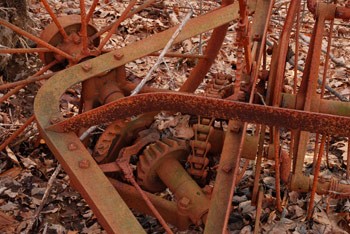
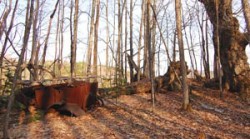
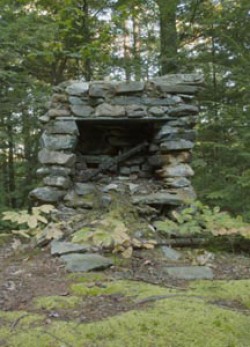

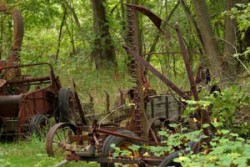
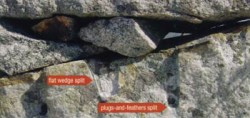
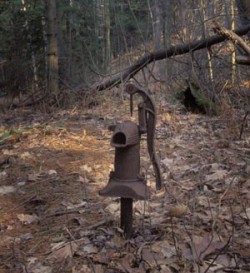



Discussion *